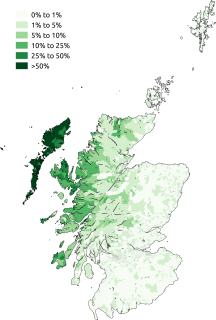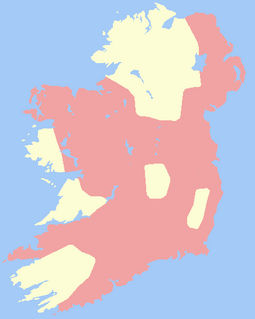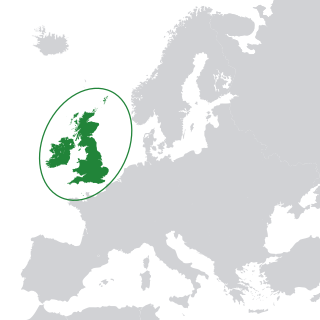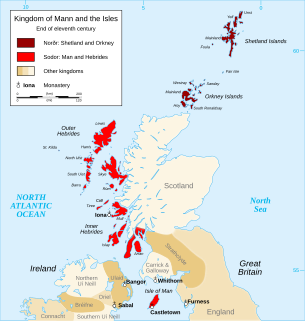Related Research Articles
The Goidelic or Gaelic languages form one of the two groups of Insular Celtic languages, the other being the Brittonic languages.

The Picts were a confederation of Celtic-speaking peoples who lived in what is today eastern and northern Scotland during the Late British Iron Age and Early Medieval periods. Where they lived and what their culture was like can be inferred from early medieval texts and Pictish stones. Their Latin name, Picti, appears in written records from Late Antiquity to the 10th century. They lived to the north of the rivers Forth and Clyde. Early medieval sources report the existence of a distinct Pictish language, which today is believed to have been an Insular Celtic language, closely related to the Brittonic spoken by the Britons who lived to the south.

Scottish Gaelic or Scots Gaelic, sometimes also referred to simply as Gaelic, is a Goidelic language of the Celtic and Indo-European language family, native to the Gaels of Scotland. As a Goidelic language, Scottish Gaelic, like Modern Irish and Manx, developed out of Old Irish. It became a distinct spoken language sometime in the 13th century in the Middle Irish period, although a common literary language was shared by Gaels in both Ireland and Scotland down to the 16th century. Most of modern Scotland was once Gaelic-speaking, as evidenced especially by Gaelic-language placenames.

The Pale or the English Pale was the part of Ireland directly under the control of the English government in the Late Middle Ages. It had been reduced by the late 15th century to an area along the east coast stretching from Dalkey, south of Dublin, to the garrison town of Dundalk. The inland boundary went to Naas and Leixlip around the Earldom of Kildare, towards Trim and north towards Kells. In this district, many townlands have English or French names.

The Lordship of Ireland, sometimes referred to retroactively as Norman Ireland, was the part of Ireland ruled by the King of England and controlled by loyal Anglo-Norman lords between 1177 and 1542. The lordship was created as a Papal fief following the Norman invasion of Ireland in 1169–1171. As the lord of Ireland was also the king of England, he was represented locally by a governor, variously known as justiciar, lieutenant, or Lord Deputy.
Tanistry is a Gaelic system for passing on titles and lands. In this system the Tanist is the office of heir-apparent, or second-in-command, among the (royal) Gaelic patrilineal dynasties of Ireland, Scotland and Mann, to succeed to the chieftainship or to the kingship.
In medieval Europe, a march or mark was, in broad terms, any kind of borderland, as opposed to a notional "heartland". More specifically, a march was a border between realms, and/or a neutral/buffer zone under joint control of two states, in which different laws might apply. In both of these senses, marches served a political purpose, such as providing warning of military incursions, or regulating cross-border trade, or both.

English, in various dialects, is the most widely spoken language of the United Kingdom, however there are a number of regional languages also spoken. There are 14 indigenous languages used across the British Isles: 5 Celtic, 3 Germanic, 3 Romance, and 3 sign languages. There are also many immigrant languages spoken in the British Isles, mainly within inner city areas; these languages are mainly from South Asia and Eastern Europe.

The Kingdom of England was a sovereign state on the island of Great Britain from 927, when it emerged from various Anglo-Saxon kingdoms until 1707, when it united with Scotland to form the Kingdom of Great Britain.

The Plantation of Ulster was the organised colonisation (plantation) of Ulster – a province of Ireland – by people from Great Britain during the reign of King James VI & I. Most of the colonists came from Scotland, the majority having a different culture to the natives. Small private plantations by wealthy landowners began in 1606, while the official plantation began in 1609. Most of the land colonised was forfeited from the native Gaelic chiefs, several of whom had fled Ireland for mainland Europe in 1607 following the Nine Years' War against English rule. The official plantation comprised an estimated half a million acres (2,000 km²) of arable land in counties Armagh, Cavan, Fermanagh, Tyrone, Tyrconnell and Derry/Londonderry. Land in counties Antrim, Down and Monaghan was privately colonised with the king's support.

The Britons, also known as Celtic Britons or Ancient Britons, were Celtic people who inhabited Great Britain from at least the British Iron Age into the Middle Ages, at which point their culture and language diverged into the modern Welsh, Cornish and Bretons. They spoke the Common Brittonic language, the ancestor to the modern Brittonic languages.

The terminology of the British Isles refers to the various words and phrases that are used to describe the different geographical and political areas of the islands of Great Britain, Ireland, and the smaller islands which surround them. The terminology is often a source of confusion, partly owing to the similarity between some of the actual words used, but also because they are often used loosely. In addition, many of the words carry both geographical and political connotations which are affected by the history of the islands.
The Kingdom of Alba refers to the Kingdom of Scotland between the deaths of Donald II in 900 and of Alexander III in 1286, which then led indirectly to the Scottish Wars of Independence. The name is one of convenience, as throughout this period the elite and populace of the Kingdom were predominantly Pictish-Gaels or later Pictish-Gaels and Scoto-Norman, and differs markedly from the period of the Stuarts, in which the elite of the kingdom were speakers of Middle English, which later evolved and came to be called Lowland Scots. There is no precise Gaelic equivalent for the English terminology "Kingdom of Alba", as the Gaelic term Rìoghachd na h-Alba means 'Kingdom of Scotland'. English-speaking scholars adapted the Gaelic name for Scotland to apply to a particular political period in Scottish history during the High Middle Ages.

Scotland in the Middle Ages concerns the history of Scotland from the departure of the Romans to the adoption of major aspects of the Renaissance in the early sixteenth century.

The Norse–Gaels were a people of mixed Gaelic and Norse ancestry and culture. They emerged in the Viking Age, when Vikings who settled in Ireland and in Scotland adopted Gaelic culture and intermarried with Gaels. The Norse–Gaels dominated much of the Irish Sea and Scottish Sea regions from the 9th to 12th centuries. They founded the Kingdom of the Isles, the Kingdom of Dublin, the Lordship of Galloway, and a Norse-Gaelic family briefly ruled the Kingdom of York. The most powerful Norse–Gaelic dynasty were the Uí Ímair or House of Ivar.

The High Middle Ages of Scotland encompass Scotland in the era between the death of Domnall II in 900 AD and the death of King Alexander III in 1286, which was an indirect cause of the Scottish Wars of Independence.
Scottish Marches was the term used for the Anglo-Scottish border during the late medieval and early modern eras, characterised by violence and cross-border raids. The Scottish Marches era came to an end during the first decade of the 17th century following the union of the crowns of England and Scotland.

The languages of Scotland are the languages spoken or once spoken in Scotland. Each of the numerous languages spoken in Scotland during its recorded linguistic history falls into either the Germanic or Celtic language families. The classification of the Pictish language was once controversial, but it is now generally considered a Celtic language. Today, the main language spoken in Scotland is English, while Scots and Scottish Gaelic are minority languages. The dialect of English spoken in Scotland is referred to as Scottish English.

Gaelic Ireland was the Gaelic political and social order, and associated culture, that existed in Ireland from the prehistoric era until the early 17th century. Before the Norman invasion of 1169, Gaelic Ireland comprised the whole island. Thereafter, it comprised that part of the country not under foreign dominion at a given time. For most of its history, Gaelic Ireland was a "patchwork" hierarchy of territories ruled by a hierarchy of kings or chiefs, who were elected through tanistry. Warfare between these territories was common. Occasionally, a powerful ruler was acknowledged as High King of Ireland. Society was made up of clans and, like the rest of Europe, was structured hierarchically according to class. Throughout this period, the economy was mainly pastoral and money was generally not used. A Gaelic Irish style of dress, music, dance, sport, architecture, and art can be identified, with Irish art later merging with Anglo-Saxon styles to create Insular art.

The Gaels are an ethnolinguistic group native to Ireland, Scotland and the Isle of Man in northwestern Europe. They are associated with the Gaelic languages: a branch of the Celtic languages comprising Irish, Manx and Scottish Gaelic. Historically, the ethnonyms Irish and Scots referred to the Gaels in general, but the scope of those ethnicities and nationalities is today more complex.
References
- 1 2 Gearóid Mac Niocaill, "March Law", in S. J. Connolly, ed., The Oxford Companion to Irish History, 2nd ed. (Oxford University Press, 2002 [online 2007]), retrieved 2016-03-28.